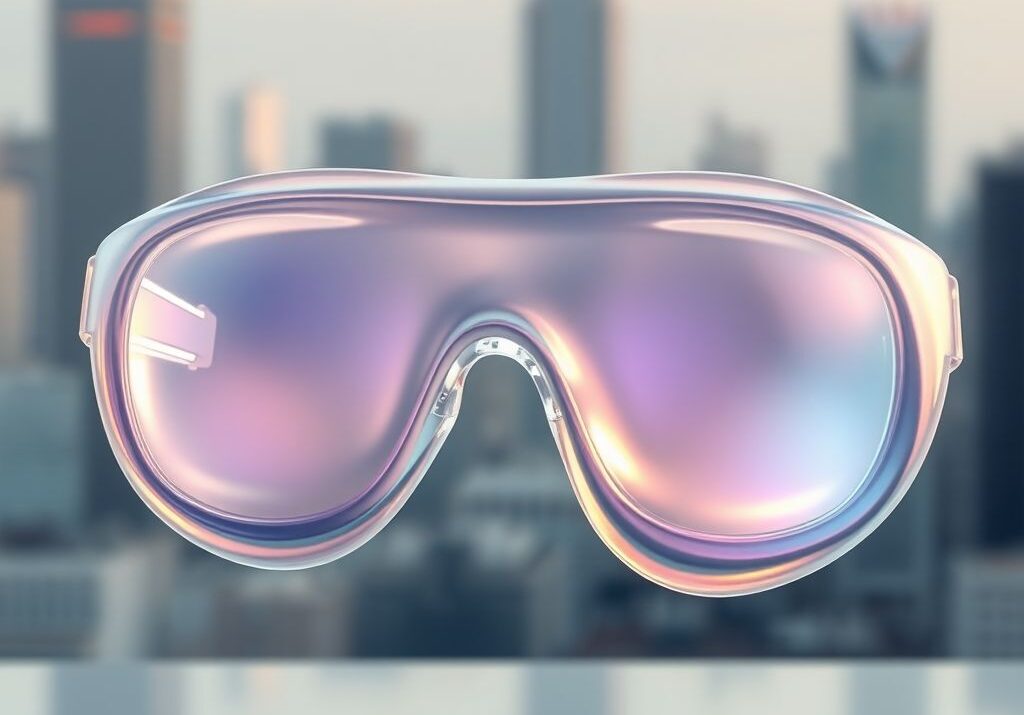Ever get that feeling when a company does something new, and you just know there’s more to the story? That’s the vibe I got after seeing Apple’s recent visual overhaul. It’s slick, smooth, and almost…liquid. Turns out, it might be a sneaky preview of something bigger: Apple’s rumored AR glasses, supposedly hitting the scene next year.
I stumbled upon an interesting piece on TechCrunch that connects the dots, and honestly, it’s got me buzzing with anticipation. The article suggests that this “liquid glass” design language isn’t just a pretty aesthetic; it’s laying the groundwork for how we’ll interact with Apple’s augmented reality world. Think seamless transitions, fluid interfaces, and a design that blends technology and reality in a way we haven’t quite seen before.
Apple’s been quietly building up its AR arsenal for years. Remember ARKit? That was just the beginning. Analysts predict the AR/VR market is set to explode, with forecasts estimating a $50.95 billion market size in 2024, reaching a staggering $252.18 billion by 2029 (according to Mordor Intelligence). Apple doesn’t want to miss out on that action.
And while many tech companies are chasing this dream, Apple’s design prowess could be the key to unlocking mainstream adoption. Imagine a pair of glasses that are both stylish and powerful, seamlessly layering digital information onto your real-world view. That’s the Apple promise, right? Elegant simplicity masking complex technology.
So, what does this liquid glass design actually mean for AR glasses? Here are my thoughts:
- Intuitive Navigation: Imagine swiping and interacting with AR elements as naturally as you do on your iPhone, all thanks to intuitive, glass-like interfaces.
- Seamless Integration: No clunky overlays or jarring transitions. The liquid design could create a sense of depth and realism, making AR elements feel like they’re actually part of your environment.
- Effortless Learning Curve: Apple’s always been about user-friendliness. A liquid glass interface could make AR more accessible to everyone, even those who aren’t tech-savvy.
- A Focus on Aesthetics: Let’s face it, nobody wants to wear something that looks like it belongs in a sci-fi movie. This design direction hints at a device that’s as fashionable as it is functional.
- Beyond the Screen: The liquid glass design suggests a move away from traditional screen-based interactions and towards a more immersive, hands-on experience.
If Apple can pull this off, it could be a real game-changer (okay, I almost said it!). The TechCrunch article definitely got me thinking, and I’m eager to see if this liquid glass design translates into a truly remarkable AR experience.
5 Key Takeaways:
- Apple’s new “liquid glass” design may be a sneak peek at its upcoming AR glasses.
- The AR/VR market is predicted to experience massive growth in the coming years.
- Apple’s focus on design could be a major advantage in the AR space.
- Liquid glass could lead to more intuitive and seamless AR interactions.
- Aesthetics are key to mainstream adoption of AR glasses.
Frequently Asked Questions (FAQs):
- What is “liquid glass” design? It’s a design language characterized by smooth, fluid interfaces and a sense of depth, aiming to create a more natural and intuitive user experience.
- When are Apple’s AR glasses expected to be released? Rumors suggest a potential release in 2026, but this is still speculation.
- What will Apple’s AR glasses be used for? Potential applications include navigation, communication, entertainment, and productivity, layering digital information onto your real-world view.
- How much will Apple’s AR glasses cost? Pricing is unknown, but analysts expect them to be a premium product.
- Will Apple’s AR glasses require an iPhone to work? It’s possible they’ll integrate with the iPhone ecosystem, but they may also have some independent functionality.
- Are there any other companies working on AR glasses? Yes, companies like Meta, Google, and Microsoft are also developing AR/VR technology.
- What are the potential benefits of AR glasses? AR glasses could enhance productivity, improve communication, and provide immersive entertainment experiences.
- What are the potential drawbacks of AR glasses? Concerns include privacy, cost, and potential for distraction.
- How will AR glasses impact our daily lives? AR glasses could change how we interact with technology, access information, and experience the world around us.
- Is Apple the first company to use “liquid glass” design? While the term might be new, the design principles behind it have been explored by others in the past. However, Apple’s take on it could be unique and influential.








